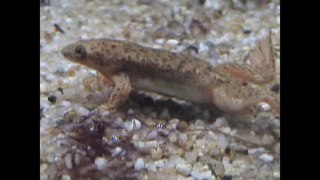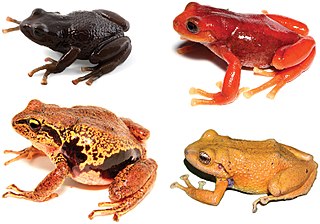Hoplophryne is a genus of microhylid frogs endemic to Tanzania.

Conraua, known as slippery frogs or giant frogs is a genus of large frogs from sub-Saharan Africa. Conraua is the only genus in the family Conrauidae. Alternatively, it may be placed in the family Petropedetidae.

The Mexican narrow-mouthed toad is a species of sheep frog native to the Pacific and Caribbean lowlands from southern Texas to Costa Rica. Sheep frogs make a distinctive call that resembles a sheep's bleat during and after rainfall in warm months.
Hyloxalus fuliginosus is a species of frog in the family Dendrobatidae. It may be endemic to Ecuador where it is known from the Amazonian slopes of the Andes in the northern Ecuador, with some sources reporting it from Colombia and Venezuela.
The golden banana frog, golden dwarf reed frog, golden spiny reed frog, or golden leaf-folding frog is a species of frog in the family Hyperoliidae. It is found in lowland coastal plains of eastern South Africa, Swaziland, and southern Mozambique. The AmphibiaWeb includes Afrixalus crotalus in this species as a subspecies, whereas the Amphibian Species of the World and the IUCN Red List of Threatened Species treat A. crotalus as a full species.
Chrysobatrachus is a genus of frogs in the family Hyperoliidae. It is monotypic, being represented by the single species, Chrysobatrachus cupreonitens. It is endemic to the Itombwe Mountains in the eastern Democratic Republic of the Congo.

Leptopelis broadleyi is a species of frog in the family Arthroleptidae of uncertain status. The Amphibian Species of the World, the IUCN SSC Amphibian Specialist Group, and the African Amphibians do not recognize it, but instead consider it synonym with Leptopelis argenteus. However, the AmphibiaWeb recognizes it as a valid species.

Leptopelis macrotis, sometimes called the big-eyed forest tree frog, is a species of frog in the family Arthroleptidae. It is found in the rainforests of Sierra Leone, southern Guinea, Liberia, Ivory Coast, and southern Ghana. Notice that similar common name "big-eyed tree frog" is sometimes used for Leptopelis vermiculatus from Tanzania and for Litoria exophthalmia from New Guinea.
Leptopelis modestus is a species of frog in the family Arthroleptidae. Its common names are modest forest treefrog and plain tree frog.
Opisthothylax is a monotypic frog genus in the family Hyperoliidae. The sole species is Opisthothylax immaculatus, also known as the gray-eyed frog . It is found in southern Nigeria, Cameroon, Equatorial Guinea, Gabon, western Republic of Congo, and southwestern Democratic Republic of the Congo. It might also be present in the Cabinda Enclave of Angola and in the Central African Republic.
Eleutherodactylus inoptatus is a species of frog in the family Eleutherodactylidae endemic to Hispaniola; it is found both in Haiti and the Dominican Republic. With female snout–vent length of about 88 mm (3.5 in), it is the largest eleutherodactylid frog.
Phyzelaphryne miriamae, commonly known as Miriam's frog, is a species of frog in the family Eleutherodactylidae. It is endemic to Brazil where it is found in the drainage of Madeira and Tapajos rivers, in the southern Amazon Basin. It might also occur in Bolivia.
The Hogsback frog, or Rattray's forest frog, is a species of frog in the family Pyxicephalidae. It is one of three species within the genus Anhydrophryne. It is endemic to the Eastern Cape province of South Africa.
Nothophryne broadleyi is a species of frog in the family Pyxicephalidae found on Mount Mulanje (Malawi). It was monotypic within the genus Nothophryne until four new species were described in 2018.

Merlin's dwarf gray frog, or Merlin's clawed frog, is a species of frog in the family Pipidae. It is monotypic within the genus Pseudhymenochirus. It is found in southern Guinea-Bissau, western Guinea, and southern Sierra Leone.

The Pyxicephalidae are a family of frogs found in sub-Saharan Africa.

The frog family Dicroglossidae occurs in tropical and subtropical regions of Asia and Africa, with most genera and species being found in Asia. The common name of the family is fork-tongued frogs.

The Craugastoridae, or fleshbelly frogs, are a family of New World direct-developing frogs. As delineated here, following the Amphibian Species of the World, it is a large family containing 857 species. They are found from the southern United States southwards to Central and South America.
Kassina jozani is a species of frogs in the family Hyperoliidae. It is endemic to Tanzania and only known from the Jozani Forest on the Unguja Island (Zanzibar).

Natalobatrachus bonebergi, the Natal diving frog, Boneberg's frog, or Kloof frog ), is a species of frog in the family Pyxicephalidae. It is the only species within the monotypic genus Natalobatrachus. It is endemic to South Africa. Its natural habitats are temperate forests and rivers and it is threatened by habitat loss.










